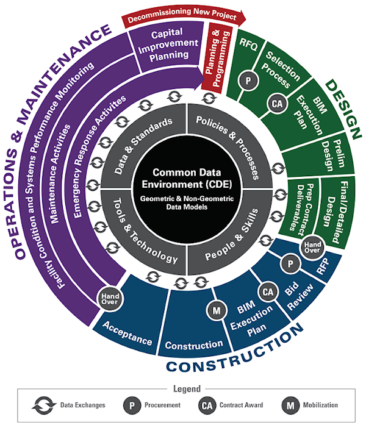The transportation industry is shifting toward 3D digital delivery of plans, defined as Model as the Legal Document (MALD). Two-dimensional plans are quickly becoming obsolete, and are being replaced with digital Building Information Modeling (BIM) Infrastructure models as the contract document for delivery. This is part of a larger change toward 3D digital delivery overall, from funding through design and construction. In fact, the Infrastructure Investment and Jobs Act (IIJA) includes a program designed to encourage DOTs to adopt advanced digital technologies to deliver their projects.

Building Information Modeling (BIM) for Infrastructure Overview.
2016 Federal Ministry of Transport and Digital Infrastructure. Modified by FHWA to include U.S. practices and lifecycle phases and to reflect specific report recommendations.
In response to this shift, the American Association of State Highway and Transportation Officials (AASHTO) has formed a committee dedicated to creating a 3D standard. As part of our work on the AASHTO committee, Mead & Hunt is moving forward creating processes and systems for our staff to be able to effectively deliver this technology. This will allow our projects and clients to reap the benefits this technology can bring. If you want to do the same at your organization, read on for insights I’ve gained through our experience at Mead & Hunt.
5 tips for developing a MALD program at your organization
1. Build an internal system of processes that can be easily adapted to any client standard. By developing an implementation program within your organization, you can provide consistent models efficiently while appropriately managing the risks. Flexibility is key so that the processes can be adapted to each owners’ specific needs while still maintaining efficiency.
2. Create and empower champions to drive the technology. Practitioners are key to successfully building a program for developing digital models. This advanced modeling effort, using state-of-the-art technology, provides designers with challenging, engaging work. A training outline can help staff develop the skills they need to build and review these models. By empowering staff, this technology can be harnessed to deliver great value to facility owners.
3. Understand risk management and the Level of Development (LOD). The LOD is a measurement of how complete the design is based on the design stage. It is important for designers to have deep understanding of the LOD so that the appropriate amount of design time is applied at the appropriate place in the design sequence. For example, some elements of the model will not need to be developed to a high level of detail, and spending time on modeling these elements detracts from the efficiency. Other elements do need a high level of detail in order to minimize risks. Understanding which is which enhances efficiency and risk management.
4. Include a robust QA/QC element. Quality control is critical with this new technology. It is important that qualified designers are able to review the critical elements of the 3D digital models. This means that veteran designers need to learn the new tools, and more tech-savvy designers should get to work with mentors. Working hand-in-hand, the experienced designers can help the tech-savvy designers understand what to look at, and the tech-savvy designers help the experienced designers understand how to look at the information. Everyone grows through exposure to this new technology, and stronger relationships are formed.
5. Get buy-in throughout your organization by promoting the benefits of 3D digital construction. Digital models provide a shared, comprehensive digital representation of a built asset to plan, design, construct, operate, maintain, and manage a facility. This in turn supports reliable decision-making, maximized efficiency, and reduces costs throughout the lifecycle of the facility. Digital models go well beyond 3D, and include up to seven dimensions, including schedule, costs, sustainability, and maintenance.
Sharing these benefits with facility owners helps everyone. Projects are completed more efficiently, and cost savings already seen in the construction industry have been substantial. While the process of shifting toward 3D digital construction and implementing a MALD program may seem overwhelming, the benefits are well worth the effort. I look forward to seeing how this new technology develops, and our Mead & Hunt team remains committed to staying on the cutting edge of this industry-wide shift.



